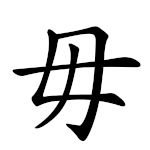
Summary
Radical 80 or radical do not (毋部) meaning "mother" or "do not" is one of the 34 Kangxi radicals (214 radicals in total) composed of 4 strokes. Chinese characters with a similar component 母 "mother" may also be classified under this radical.
| 毋 | ||
|---|---|---|
| ||
| 毋 (U+6BCB) "mother, do not" | ||
| Pronunciations | ||
| Pinyin: | wú | |
| Bopomofo: | ㄨˊ | |
| Wade–Giles: | wu2 | |
| Cantonese Yale: | mòuh | |
| Jyutping: | mou4 | |
| Pe̍h-ōe-jī: | bû | |
| Japanese Kana: | ブ bu / ム mu (on'yomi) なかれ nakare (kun'yomi) | |
| Sino-Korean: | 무 mu | |
| Names | ||
| Japanese name(s): | なかれ nakare ははのかん hahanokan | |
| Hangul: | 말 mal | |
| Stroke order animation | ||
 | ||
In the Kangxi Dictionary, there are 16 characters (out of 49,030) to be found under this radical.
毋 is also the 99th indexing component in the Table of Indexing Chinese Character Components predominantly adopted by Simplified Chinese dictionaries published in mainland China.
In the Hokkien language, 毋 is often used to represent the negation particle [m̩], spelled m̄ in Peh-oe-ji and Tai-lo.
Evolution edit
-
Bronze script character
-
Large seal script character
-
Small seal script character
Derived characters edit
| Strokes | Characters |
|---|---|
| +0 | 毋SC/TC/毋JP 毌 |
| +1 | 母 |
| +2 | 毎JP (=每) |
| +3 | 每 毐 |
| +4 | 毑 毒TC/毒JP |
| +9 | 毒SC 毓 |
Sinogram edit
The radical is also used as an independent Chinese character. It is one of the Kyōiku kanji or Kanji taught in elementary school in Japan.[1] It is a second grade kanji[1]
References edit
Literature edit
- Fazzioli, Edoardo (1987). Chinese calligraphy : from pictograph to ideogram : the history of 214 essential Chinese/Japanese characters. calligraphy by Rebecca Hon Ko. New York: Abbeville Press. ISBN 0-89659-774-1.
- Lunde, Ken (Jan 5, 2009). "Appendix J: Japanese Character Sets" (PDF). CJKV Information Processing: Chinese, Japanese, Korean & Vietnamese Computing (Second ed.). Sebastopol, Calif.: O'Reilly Media. ISBN 978-0-596-51447-1.
External links edit
- Unihan Database - U+6BCB


